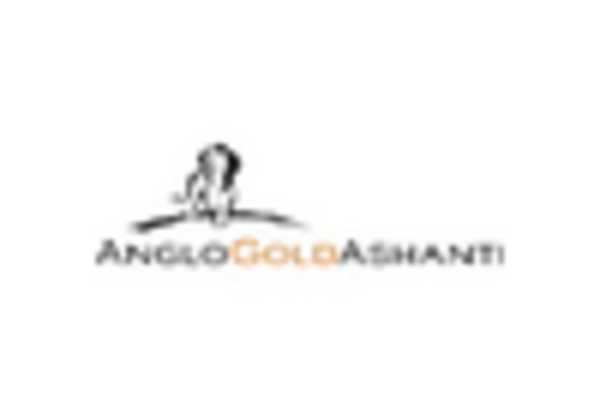Market Demand Fluctuations
The Gold Mining Market in North America is significantly influenced by fluctuations in demand for gold, driven by various factors such as economic stability, inflation rates, and geopolitical tensions. In recent years, gold has been viewed as a safe-haven asset, particularly during times of economic uncertainty. For instance, in 2024, gold prices surged to an average of $2,000 per ounce, reflecting heightened demand amid global economic concerns. This demand is expected to continue influencing mining operations, as companies adjust their production strategies to align with market trends. The interplay between demand and supply dynamics is crucial for the gold mining market, as it directly impacts profitability and investment decisions.
Regulatory Framework Enhancements
The regulatory landscape surrounding the Gold Mining Market in North America is evolving, with governments implementing stricter environmental and safety regulations. These enhancements aim to ensure sustainable practices while promoting responsible mining operations. As a result, companies are increasingly investing in compliance measures, which may lead to higher operational costs. However, adherence to these regulations can enhance the reputation of mining firms, potentially attracting more investors. In 2023, the average cost of compliance for mining companies in North America was estimated at $1.5 million annually, indicating a significant financial commitment. This regulatory framework is likely to shape the future of the gold mining market, as firms that prioritize compliance may gain a competitive edge in an increasingly scrutinized industry.
Investment Trends in Mining Projects
Investment trends in the Gold Mining Market are shifting, with a noticeable increase in funding directed towards exploration and development projects. In 2025, North America saw a 15% rise in investments in mining ventures, driven by favorable market conditions and the potential for high returns. Institutional investors are increasingly recognizing the value of gold as a hedge against inflation, prompting a surge in capital allocation to mining companies. This influx of investment is expected to facilitate the discovery of new gold deposits and enhance production capabilities, thereby positively impacting the overall market landscape. The focus on investment in mining projects is likely to shape the future trajectory of the gold mining market.
Technological Integration in Operations
The integration of advanced technologies in the Gold Mining Market is transforming operational efficiencies and productivity. Innovations such as automation, artificial intelligence, and data analytics are being adopted to optimize extraction processes and reduce costs. For example, companies utilizing automated drilling systems have reported a 20% increase in productivity while minimizing labor costs. This technological shift not only enhances operational performance but also contributes to safer working environments. As the industry continues to embrace these advancements, the gold mining market is likely to witness a paradigm shift, where technology plays a pivotal role in shaping competitive strategies and operational frameworks.
Environmental Sustainability Initiatives
Environmental sustainability initiatives are becoming a focal point in the Gold Mining Market, as companies strive to minimize their ecological footprint. In North America, mining firms are increasingly adopting practices that promote resource conservation and waste reduction. For instance, the implementation of water recycling systems has been shown to reduce water usage by up to 30%, aligning with broader environmental goals. These initiatives not only address regulatory pressures but also resonate with consumers and investors who prioritize sustainability. As the gold mining market evolves, the emphasis on environmental responsibility is likely to influence operational strategies and corporate reputations, potentially leading to enhanced market positioning.

















Leave a Comment